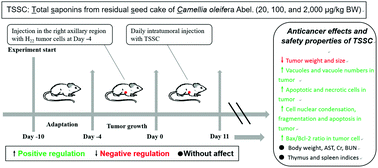Anticancer activity and mechanism of total saponins from the residual seed cake of Camellia oleifera Abel. in hepatoma-22 tumor-bearing mice
Abstract
We have previously demonstrated that several new saponins from the seed cake of Camellia oleifera Abel. exhibited antiproliferative activity against human tumor cells in vitro. The current study investigated the effect of total saponins from the residual seed cake of Camellia oleifera Abel. (TSSC) on anticancer activity in hepatoma-22 tumor-bearing mice and discovered that TSSC induced apoptosis of cancer cells in mice with hepatoma-22 solid tumors. In mice with hepatoma-22 solid tumors, daily intratumoral injections with TSSC at the doses of 20 μg kg−1, 100 μg kg−1, or 2000 μg kg−1 were administered for 10 consecutive days, a regimen which was well tolerated by the mice and significantly inhibited tumor growth. Moreover, TSSC promoted solid tumor cell apoptosis, upregulated the protein expression of Bax, and downregulated the protein expression of Bcl-2 in response to regulate apoptosis of cancer cells in mice bearing hepatoma 22 solid tumors. At the same time, the direct structure–activity relationship between camelliasaponins B1, Bcl-2 and MDM2 in TSSC was investigated by molecular docking. It was verified that the glycosidic ligand on C3 is the main source of anticancer activity. Taken together, these results indicated that TSSC could exhibit anticancer activity and increase apoptosis of cancer cells in hepatoma-22 tumor-bearing mice, making it a potential adjuvant drug after further investigation in the future.



 Please wait while we load your content...
Please wait while we load your content...